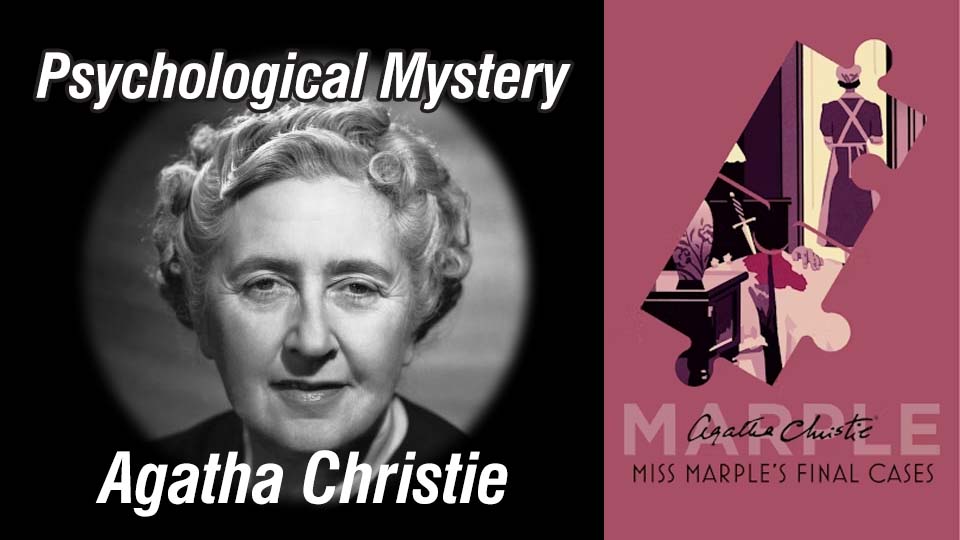Psychological mystery as a literary genre reaches its finest expression in the works of Agatha Christie, the legendary “Queen of Crime.” No writer has explored the human mind — its fears, jealousies, and hidden motives — with such precision and brilliance. Christie’s stories go far beyond traditional detective fiction; they unravel the intricate emotions that lead to crime itself. Among her many masterpieces, “In a Glass Darkly” stands as a rare gem — a tale where suspense, foresight, and psychological terror intertwine to create one of her most haunting and unforgettable narratives.
The Timeless Appeal of Psychological Mystery
psychological mystery goes beyond solving a crime — it dissects the very mind that commits it. Agatha Christie understood this better than anyone. Her works did not simply entertain; they compelled readers to question human nature itself. This particular story, “In a Glass Darkly,” is not about clever detectives or calculated murders — it is about the haunting battle between destiny and self, and how our fears can become the architects of our downfall.
A Story That Sees Beyond Reality
Published in 1934, “In a Glass Darkly” follows a man who sees a vision in a mirror. At Neil Carslake’s mansion, “The Sunny,” the narrator glimpses a blonde girl lying lifeless as a man strangles her in rage. He rushes to stop the murder, but finds only a cupboard, not a door.
This eerie incident sets the stage for a psychological mystery that transcends time. Later, the narrator meets Neil’s sister Sylvia and her fiancé, Charles Crawley, and he is shocked. Sylvia looks exactly like the girl from his vision, and Charles bears a scar on his neck, just like the killer he saw. The vision becomes a prophecy, one that begins to weigh on his mind, blending fate with fear.
A Prophecy Fulfilled — The Darkness Within
As the story unfolds, the events predicted by the mirror eerily come to pass. Years later, when the narrator marries Sylvia, the same jealousy and insecurity that once haunted his vision begin to consume him. In a fit of anger, he grabs Sylvia by the throat — and in that very moment, the same reflection he once saw in the mirror flashes before his eyes. The terrifying truth hits him: he was the killer he had seen all those years ago.
This twist transforms “In a Glass Darkly” from a ghostly tale into a psychological mystery about self-destruction and the inevitability of fate. It is a story not merely of murder, but of the human psyche — how fear and jealousy can manifest the very horrors we try to escape.
Urdu Translation and the Legacy in Urdu Digest
The Urdu-speaking audience was introduced to this remarkable psychological mystery through the translation by Shahid Hameed (late), which was published in Urdu Digest in January 1982. Hamid’s masterful translation captured the haunting beauty and emotional depth of Christie’s original text. Later, AwazeUrdu brought this story to life again by presenting the same translation in an engaging audio-video format, allowing a new generation of listeners to experience its thrill.
The Urdu version remains a shining example of how great English fiction can transcend linguistic boundaries. It also demonstrates that mystery, emotion, and the exploration of the human mind — the core of any psychological mystery — are truly universal.
Why Agatha Christie Still Rules the Human Mind
Agatha Christie’s genius lay not in constructing puzzles, but in reflecting the unseen conflicts of the heart. “In a Glass Darkly” compels us to look at the mirror of our own conscience. The reflection may frighten us — but it also teaches that the greatest mystery lies within ourselves.
Her work reminds readers that a psychological mystery is not just about ghosts or crime; it is about the mind’s power to create, destroy, and redeem. That is why even after decades, her stories remain relevant, gripping, and unforgettable.
Conclusion
“In a Glass Darkly” is more than a detective story — it is a mirror of human emotion. Through its blend of suspense and introspection, it continues to be one of the finest examples of a psychological mystery ever written. Agatha Christie turned fear into philosophy and mystery into meaning. Her timeless tales still whisper to every reader: “The scariest mysteries are not out there — they live within us.
If you’re interested in reading this book, click the link below for a free download.
https://drive.google.com/file/d/1lIZz4IsCs8C3ZVwmj7qu7uNh7M2hoqJ9/view?usp=sharing
If you’d like to listen to this book in audio format, click the CONTACT button below to get in touch with the AwazeUrdu team to order the audiobook.
You can also watch the same video on these social media platforms.
دنیا کے ادبی ذخیرے میں اگر کسی صنف نے سب سے زیادہ سنسنی، تجسس اور ذہنی آزمائش کو جنم دیا ہے تو وہ ’’سِرّی‘‘ یا ’’جاسوسی ادب‘‘ ہے۔ اس صنف کی ابتدا مغرب میں ہوئی، جہاں انگریزی ادب میں کئی ممتاز ادیبوں نے اسرار و معما پر مبنی کہانیاں لکھیں۔ رفتہ رفتہ یہ کہانیاں اردو میں ترجمہ ہو کر برصغیر کے قارئین تک پہنچیں، اور بعدازاں اردو ادیبوں نے بھی اسی رنگ میں طبع آزمائی شروع کی۔ انگریزی جاسوسی ادب کے نامور مصنفین میں اگاتھا کرسٹی کا شمار سب سے نمایاں اور مقبول ترین ناموں میں ہوتا ہے، جن کی کہانیوں نے نہ صرف مغرب بلکہ مشرقی دنیا میں بھی قارئین کو مسحور کر رکھا ہے۔
جاسوسی ادب کی ملکہ، اگاتھا کرسٹی ، 15 ستمبر 1890ء کو انگلینڈ کے شہر ٹورکی میں پیدا ہوئیں اور 12 جنوری 1976ء کو آکسفورڈشائر میں وفات پائیں۔ وہ دنیا کی سب سے زیادہ پڑھی جانے والی مصنفہ ہیں، جن کی کتابوں کے دو ارب سے زائد نسخے فروخت ہو چکے ہیں اور جن کے ناولوں کا ترجمہ سو سے زیادہ زبانوں میں ہو چکا ہے۔ انہوں نے تقریباً 66 جاسوسی ناول اور 14 مختصر کہانیوں کے مجموعے تحریر کیے، جن میں ہرکول پوئرو اور مس مارپل جیسے مشہور کردار تخلیق کیے۔ ان کا طویل ترین تھیٹر ڈرامہ The Mousetrap لندن کے ویسٹ اینڈ میں ریکارڈ مدت تک پیش کیا جاتا رہا۔ جنگِ عظیمِ اوّل کے دوران انہوں نے اسپتال کے دواخانے میں کام کیا، جس کے باعث زہروں اور دواؤں کے بارے میں ان کا علم ان کی کہانیوں میں نمایاں نظر آتا ہے۔ 1926ء میں ان کا پراسرار طور پر گیارہ دن تک غائب رہنا بھی ایک معمہ بنا رہا۔ ان کی ادبی خدمات کے اعتراف میں 1971ء میں برطانوی حکومت نے انہیں ’’ڈی م کمانڈر آف دی آرڈر آف دی برٹش ایمپائر‘‘ کا اعزاز دیا۔
اگاتھا کرسٹی کی ایک کہانی
“In a Glass Darkly”
پراسرار پیش بینی پر مبنی داستان ہے،جوپہلی بار 1934ء میں ایک امریکی رسالے میں شائع ہوئی۔ دلچسپ امر یہ ہے کہ اس سے قبل برطانوی اخبارڈیلی میل نے غلطی سے یہ خبر شائع کر دی تھی کہ اگاتھا کرسٹی یہ کہانی بی بی سی ریڈیو پر پڑھنے والی ہیں، حالانکہ وہ مصنفہ ڈوروتھی ایل سیئرز سے خلط ملط کر بیٹھے تھے۔ بعد ازاں، یہ کہانی 1939ء میں The Regatta Mystery and Other Stories کے مجموعے میں کتابی شکل میں شائع ہوئی، جب کہ برطانیہ میں 1979ء میں Miss Marple’s Final Cases کے حصے کے طور پر شامل کی گئی۔ 1982ء میں اس کہانی پر ٹیلی ویژن ڈرامہ تیار کیا گیا اور 2010ء میں بی بی سی ریڈیو 4 نے اسے صوتی ڈرامے کی صورت میں پیش کیا۔ اس کا اردو ترجمہ شاہد حمید مرحوم نے کیا، جو جنوری 1982ء میں اردو ڈائجسٹ میں شائع ہوا، اور بعدازاں آوازِ اردو نے اسی ترجمے کو ویڈیو کی شکل میں پیش کیا۔
اس پُراسرار کہانی کا راوی خود وہ شخص ہے جس کے ساتھ ایک ناقابلِ فہم واقعہ پیش آتا ہے۔ وہ بتاتا ہے کہ یہ واقعہ 1913ء میں پیش آیا، جب وہ اپنے دوست نیل کارسلیک کے ساتھ اس کے آبائی گھر ’’درِ سنی‘‘ گیا۔ نیل کا خاندان پرانا اور روایتی تھا، گھر وسیع مگر خستہ حالت میں تھا۔ اسی دورے میں راوی نے ایک عجیب تجربہ کیا۔ کمرے میں موجود ایک قدِ آدم آئینے میں اسے ایک ایسا منظر دکھائی دیا جس نے اس کی روح تک ہلا دی — ایک نوجوان سنہری بالوں والی لڑکی فرش پر گری ہوئی تھی اور ایک زخم زدہ شخص اس کا گلا گھونٹ رہا تھا۔ یہ منظر اتنا واضح تھا کہ وہمی خیال نہیں لگتا تھا۔ لیکن جب وہ لڑکی کو بچانے کے لیے دروازے کی طرف بڑھا تو دیکھا کہ وہاں تو کوئی دروازہ ہے ہی نہیں، صرف ایک بڑی لکڑی کی الماری موجود تھی۔
جب نیل واپس آیا تو راوی نے اس سے پوچھا کہ کیا وہاں پہلے کبھی دروازہ تھا؟ نیل نے تصدیق کی کہ واقعی وہاں کبھی دروازہ تھا جو ساتھ والے کمرے میں کھلتا تھا۔ کچھ دیر بعد راوی کی ملاقات نیل کی بہن سلویا اور اس کے منگیتر چارلس کرالے سے ہوئی — اور وہ حیران رہ گیا۔ سلویا بالکل ویسی تھی جیسی لڑکی آئینے میں نظر آئی تھی، اور چارلس کے بائیں کان سے گردن تک ایک زخم کا نشان تھا، بالکل ویسا ہی جیسا اس نے دیکھا تھا۔
یہ سب دیکھ کر راوی الجھن میں پڑ گیا۔ اس نے سلویا کو آئینے والا واقعہ بتایا۔ سلویا نے بات کو سکون سے سنا اور کہا کہ وہ یقین کرتی ہے کہ وہ جھوٹ نہیں بول رہا۔ کچھ ہی دن بعد خبر ملی کہ سلویا نے اپنی منگنی توڑ دی۔ پھر جنگ شروع ہو گئی۔ نیل اور چارلس دونوں جنگ میں مارے گئے۔ راوی نے برسوں بعد سلویا سے اپنے جذبات کا اظہار کیا اور دونوں نے شادی کر لی۔ مگر وقت گزرنے کے ساتھ اس کے دل میں شک اور حسد نے گھر کر لیا۔ ایک دن غصے میں اس نے سلویا کا گلا پکڑ لیا — اور اسی لمحے آئینے میں وہی منظر نظر آیا جو برسوں پہلے دیکھا تھا۔ مگر اب قاتل کوئی اور نہیں بلکہ وہ خود تھا۔
اس انکشاف نے اس کی روح جھنجھوڑ دی۔ اس نے سلویا کو چھوڑ دیا، جو زندہ بچ گئی۔ تب اسے احساس ہوا کہ وہ جس مستقبل سے خوفزدہ تھا، دراصل وہی خود اس کا سبب بننے والا تھا۔ سلویا اور وہ ایک دوسرے کے قریب آ گئے، اور اب وہ سکون سے کہتے ہیں کہ ’’یہ سب کچھ حقیقت تھا‘‘ — اور اب صرف موت ہی انہیں جدا کر سکتی ہے۔
اگاتھا کرسٹی کی یہ کہانی محض ایک ماورائی یا پراسرار قصہ نہیں بلکہ انسانی نفسیات، خوف، حسد، تقدیر اور پیش بینی جیسے عناصر کا گہرا تجزیہ پیش کرتی ہے۔ اس میں ایک طرف مافوق الفطرت تجربہ دکھایا گیا ہے، تو دوسری طرف انسان کے اندر چھپی ہوئی وہ تاریکی جو کبھی کبھار خود اُس کے وجود کے خلاف کھڑی ہو جاتی ہے۔ یہی وہ پہلو ہے جو اگاتھا کرسٹی کے فن کو عام جاسوسی ادب سے بلند کر دیتا ہے۔ ان کی تحریریں قاری کے ذہن میں صرف معما نہیں چھوڑتیں، بلکہ ایک آئینہ بن جاتی ہیں — ایسا آئینہ جس میں انسان کو خود اپنی ذات کی پرچھائیں دکھائی دیتی ہے

